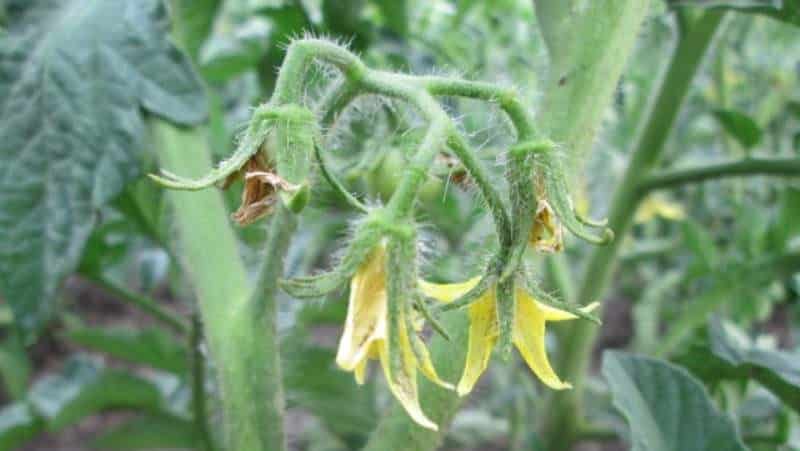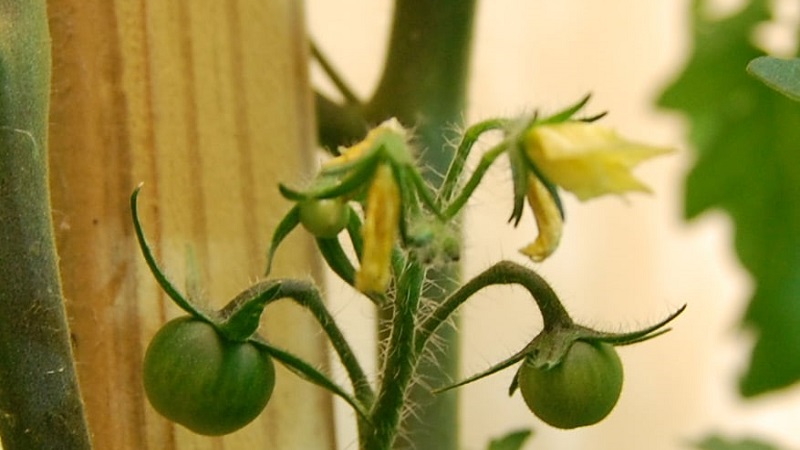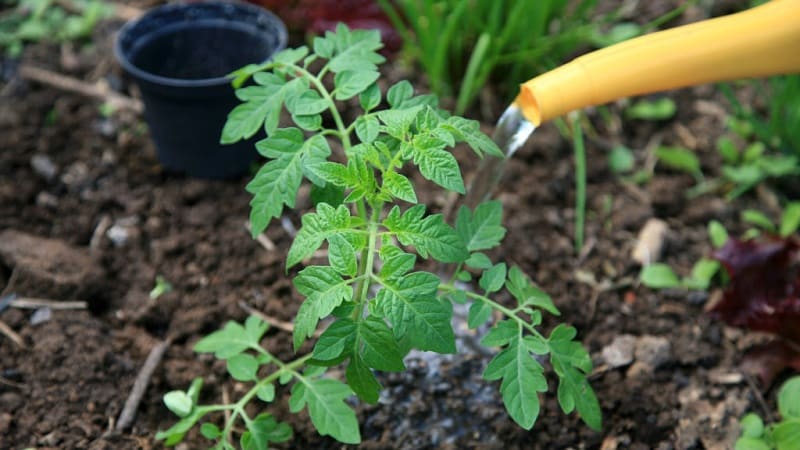How and what to feed tomatoes during flowering and fruit set to get a rich harvest of large tomatoes
Growing a tomato crop that will make your neighbors jealous is the dream of every gardener. At the same time, everyone has a natural question about how to feed tomatoes during the period of flowering and fruit set.
We will tell you what to do to ensure that tomatoes actively bloom and bear fruit, how to care for the plant and what fertilizers to apply for a good ovary.
When and what to feed tomatoes
For better fruit set, tomatoes need nitrogen, potassium and phosphorus fertilizers.
Let's consider the stages of fertilizing:
- During soil preparation. For 1 sq. m of land add 8 kg of compost or humus.
- After planting the seedlings. Use nitrogen nutrition: 1 tbsp. spoon of urea, 2 tbsp. spoons of superphosphate and potassium chloride. Fertilizer is applied per 1 square. m beds. Fertilizing with nitrogen is stopped at the beginning of flowering.
- During flowering, ovary formation and fruiting. They use potassium-phosphorus nutrition, iodine, boron.
Important! Tomatoes are fertilized every two weeks throughout the season.

What is it for
Tomatoes grow well in fertile soils. Fasting negatively affects growth and fruiting.
Factors to consider:
- The lower leaves and stem turn purple - there is not enough phosphorus. The bushes do not develop, the root system weakens, and the fruits lose their taste. They add phosphorus nutrition.Organic fertilizers are suitable for this: bird droppings, mullein, wood ash. The solution is prepared at the rate of: a bucket of water, a glass of ash, a glass of litter. The fertilizer “plays” for 2-3 days. Then it is diluted with water in the proportion of 1 liter of mixture per 10 liters of water. Water 1 liter per root.
- Leaves curl, brown-yellow spots appear - lack of potassium. The fruits stop growing and develop blossom end rot. Apply mineral fertilizers. For 1 sq. m prepare a mixture: 25 g of superphosphate, 5 g of urea, 10 g of potassium salt.
- Light green color of leaves - lack of nitrogen, plants are stunted in growth. Feed with urea: dissolve 1 teaspoon of urea in a bucket of water, pour 0.5 liters per bush.
- Few ovaries on tomatoes. Growth stimulants are used: “Ovary”, “Signor Tomato”.
Fertilizing scheme
Let's consider in what periods it is better to fertilize:
- Two weeks after planting the seeds.
- After the dive.
- After two weeks, root feeding is carried out.
- On the 14th day after planting the seedlings.
- During flowering.
- When the fruits ripen.
Important! During flowering, nitrogen fertilizers are not used.
Favorable days
When thinking about how and what to feed tomatoes during fruit set, you need to take into account the influence of the Moon on plant development.
During the waning phase of the moon, the root system grows. Seedlings planted on such days are quickly accepted. During the growing phase, the upper part of the tomatoes actively develops.
If you apply fertilizers during the days of the waning Moon, a strong bush with developed roots will grow, and if during the growing period, this will help the formation of a large number of ovaries and fruits.

In the open ground
Tomato care and fertilizing in open ground depend on the following factors:
- weather;
- soil condition.
For example, black soil needs less fertilizer than loamy and sandy soils. Proportions for applying fertilizer on loamy and sandy soils: per 1 sq. m scatter 40 g of superphosphate, 15 g of potassium salt, 10 g of urea. Add 10 kg of compost or humus. On chernozem soils the proportions are reduced.
Low temperatures and rainy weather cause nitrogen deficiency, so at this time tomatoes are fed with nitrogen fertilizers.
In the greenhouse
The specifics of growing tomatoes in a greenhouse and open ground are largely similar.
Work begins with preparing the soil. In early spring, before digging, fertilizers are applied: 10 kg of compost is mixed with 1 teaspoon of ammonium nitrate, 15 g of potassium chloride and 40 g of superphosphate. The proportion is calculated for 1 sq. m of land.
Features of caring for tomatoes in a greenhouse:
- Seedlings after diving are not fertilized. Strengthen the immune system by spraying the drug “Epin” on the leaves.
- Tomatoes in a greenhouse need more potassium fertilizers. A lack of potassium causes the leaves to wilt.
- When flowering and ovary formation, it is important to follow the watering regime. To prevent diseases from developing in the greenhouse, the humidity should be no higher than 75%.
Feeding is carried out in stages:
- On the 14th day after planting the seedlings, mineral fertilizers are applied.
- During flowering, fertilize with potassium fertilizers, bird droppings, and mullein.
- If the plants are very elongated, superphosphate is used.
- When tomatoes bloom in a greenhouse, they are fed with calcium nitrate.
- To form ovaries, use a mixture: a glass of ash, 1 teaspoon of boric acid, a bucket of water.
- During fruiting, make a solution: a bucket of water, 2 tbsp. spoons of superphosphate, 1 tbsp. spoon of sodium humate.
Important! In a greenhouse, fertilizers are applied once every two weeks, in open ground - once every 10 days.
How to water tomatoes
A good harvest can be grown using mineral and organic fertilizers. The following must be taken into account:
- To grow, tomatoes need nitrogen fertilizers: ammonium nitrate, ammonia, urea, yeast nutrition.
- When forming ovaries, fertilizers with potassium, boron, manganese, and iodine are needed. These are phosphorus-potassium fertilizers: superphosphate, potassium sulfate, boric acid, wood ash.
Boric acid
Boron is necessary for the formation of ovaries and fruit formation. Boric acid replenishes the need for boron in tomatoes. This is a safe product.
Feeding is carried out in two ways:
- Foliar method. Spray every week during flowering. Preparation of the solution: dissolve 10 g of boric acid in a glass of hot water, then add a bucket of water.
- Root feeding. Apply during flowering and ovary formation. Water once every two weeks, 1 liter per bush. The solution is prepared from a proportion of 5 g of acid per 10 liters of water.

Yeast feeding
Sometimes, during the flowering of tomatoes, the ovaries begin to dry out, and inexperienced gardeners do not know what to do or how to feed the plants. Yeast saturated with iron, amino acids, micro- and macroelements. They contain fungi that affect the growth and development of tomatoes, and also fight diseases.
To prepare the solution, use dry or fresh yeast:
- Recipe with dry yeast. In a deep bowl, dilute 100 g of dry yeast in 3 liters of warm water, add 50 g of sugar. Place in a warm place and let it ferment for a day. The resulting mixture is diluted in 10 liters of water, and 0.5 liters are poured under the bush.
- Fresh yeast recipe. 0.5 kg of fresh yeast and 0.5 liters of old jam are mixed in 5 liters of warm water. The mixture should ferment for a day in a warm place. Then 1 liter of the mixture is diluted in a bucket of water.
Important! Before applying fertilizer, plants are watered abundantly.
Yeast feeding is used no more than three times per season. The procedure is carried out at intervals of 2-3 weeks.
Herbal infusion
A product that can be prepared at home. The cut grass is placed in a barrel, filled with water, and left to ferment for a week. Add a liter jar of wood ash.
Important! To speed up the fermentation process, yeast or whey is added to the mixture.
When a strong, pungent odor appears, the fertilizer is ready. Use 1 liter of fertilizer per bucket of water, watering 1 liter per bush.
Ash
Replenishes the need of tomatoes for potassium, phosphorus, calcium.
Ash is used 2-3 times during the summer:
- in the spring for digging up the soil at the rate of 80 g per 1 sq. m;
- in mid-July - 0.5 cups per 1 sq. m.
Ash used as a separate fertilizer or included in others. It is scattered at the root before watering or dissolved in water. Use 1 glass per 10 liters of water.
Important! Ash is not used when soaking seeds.

Chicken droppings
How can you feed tomatoes to produce more ovaries? A long-used remedy is chicken manure. This is an environmentally friendly fertilizer. It contains a large amount of potassium, phosphorus, magnesium, as well as boron, zinc, and copper.
The litter is used in two ways:
- Dry chicken manure is scattered before digging in the fall or early spring. For 1 sq. m of land use 1 kg of dry manure and a glass of ash.
- Liquid feeding. Prepared from rotted droppings: 0.5 kg of droppings per 10 liters of water. They insist for three days.
Important! The solution is watered between the rows.
Fertilizer is applied 2-3 times per season. When using this product, it is important not to overdo it. Excessive fertilization can lead to increased growth of green mass.
Iodine and dairy products
In order for tomatoes to bear fruit, it is important to feed them with iodine, potassium, and iron, which are contained in dairy products. Lactic acids also actively fight fungal diseases of tomatoes.
Iodine At the same time it saturates tomatoes with essential nutrients and works as an antiseptic.
To prepare the solution, use fresh milk, whey or yogurt.
To prevent diseases, tomatoes are treated immediately after rooting. seedlings. Subsequently, spray every two weeks with a solution: 1 liter of milk, 15 drops of iodine, a bucket of water.
Important! The product is used immediately after preparation so that the iodine does not evaporate.
Humates
These natural growth stimulants are used to increase fruiting.
Properties of humates:
- improve soil structure;
- saturate with oxygen;
- improve the rooting process of seedlings;
- increase seed germination.
Feeding is carried out once every two weeks. Potassium and sodium humate are used. 1 teaspoon of powder is dissolved in a bucket of warm water. Water at the root with 0.5 liters three times per season.
Important! Humates cannot be mixed with phosphorus fertilizers and calcium nitrate.

Ready-made store-bought preparations
There is a wide variety of ready-made drugs.
Prerequisites for their use:
- The bushes stretch strongly upward - use a superphosphate solution: 4 g per 1 liter of water.
- Plants grow slowly - use the growth stimulator "Energen".
- During flowering, “Signor Tomato”, “Mortar”, and “Effecton” are used.
Mineral fertilizers
The use of mineral fertilizers when growing tomatoes gives good results.
There are three types of such fertilizers:
- Phosphorus fertilizers are used to strengthen the root system: superphosphate, phosphorus flour.
- Nitrogen stimulates the growth of green mass, increases flowering, improves taste: ammonium nitrate, ammonium sulfate, ammonium sulfate, urea.
- Potassium increases immunity and improves taste. In spring, potassium sulfate is used, in autumn - potassium chloride. Preparations should be used in moderate doses so as not to damage the root system of plants.
Important! When applying nitrogen fertilizers to the soil, lime is added, since ammonia fertilizers acidify it.
Organic fertilizers
Organic fertilizers, environmentally friendly and safe for humans, will help increase the number of ovaries. These include compost, mullein, herbal tincture, and bird droppings.
The following recipes are among the most effective:
- Herbal tincture with mullein and ash. Place 5 kg of chopped grass in a barrel of water, add 2 liters of mullein, 1 glass of ash. Infuse for two weeks, dilute 1 liter of infusion in 10 liters of water. Water 1 liter per bush. The procedure is repeated every two weeks.
- Banana peel tincture. The product stimulates fruit growth. Place 1 kg of skins in a bucket of water and leave for three days. Dilute with water in the proportion of 1 liter of tincture to 2 liters of water. Before use, add 1 g of copper sulfate to the solution.
How to water
The watering needs of tomatoes during flowering and fruiting are different.
During flowering
During this period, ovaries are formed and future fruits are laid.
Tomatoes need to be watered regularly and abundantly during the flowering period.. The watering mode is selected depending on the weather.When it's hot, water twice a week. In cool weather, once is enough.
During the fruiting period
Watering during this period it is reduced. It is carried out as necessary. Excessive watering can damage the fruits: they will crack and rot.
In hot weather, one abundant watering every 7-10 days is sufficient.
Advice from experienced summer residents
Experienced gardeners know how to feed tomatoes to set fruit in a greenhouse. What to do when tomatoes bloom but don’t set?
Take advantage of the recommendations of experts:
- Use foliar and root fertilizers throughout the growing season.
- Apply nitrogen fertilizer only at the beginning of the season to ensure a large, strong bush.
- During flowering and fruiting, use phosphorus-potassium nutrition.
- It is better to fertilize in the evening to prevent the leaves from getting sunburned.
- In rainy weather, use hydrogen peroxide. This will improve the soil structure and enrich it with oxygen. The plants will withstand bad weather better and the ovaries will not fall off.
- To form ovaries, spray with a solution of boric acid.

Reviews
How to grow a rich harvest of tomatoes and how to feed them so that there are more ovaries - experienced gardeners say.
Valentina, Voronezh: “I’ve been growing tomatoes for a long time. When I see a problem that tomatoes are blooming but there are no ovaries, I spray them with boric acid. I make a solution - 1 teaspoon of acid per 3 liters of water - and spray it every week. 2-3 times are enough for the fruit to begin to set.”
Ivan, Moscow: “I give preference to organic fertilizers. It is safe for health. I am preparing an herbal tincture from weeds. I feed it once every 14 days. I add 1 liter of tincture, a glass of ash, 1 tbsp to a bucket of water. a spoonful of superphosphate."
Inna, Tomsk: “When neighbors see my blooming tomatoes, they have a question: what do I feed them with? The secret is simple. I use nitrogen fertilizers at the beginning of growth. During the flowering period I add phosphorus and potassium. First of all, I use yeast dressing, alternating it with ammonium nitrate or ammonia. 1 tbsp. A spoonful of saltpeter in a bucket of water is enough for the bush to gain strength for fruiting. I apply fertilizer every two weeks. Then I switch to boric acid, superphosphate, and potassium nitrate.”
Conclusion
How to feed tomatoes when flowering and setting fruit? By applying nitrogen fertilizers during the period of green mass growth, you will strengthen the bushes, preparing them for fruiting. Phosphorus-potassium fertilizers will help increase the number of ovaries. By using organic products, you will protect yourself and your family.